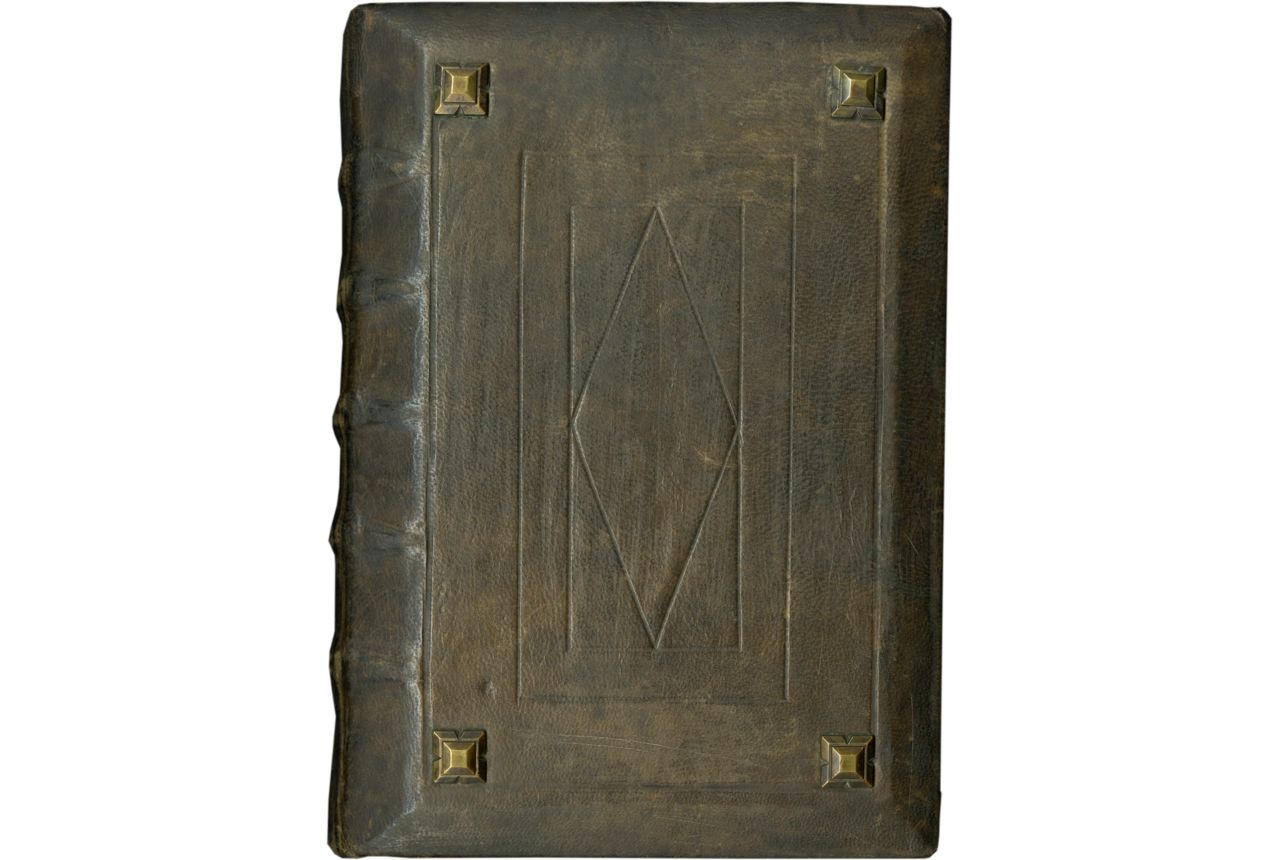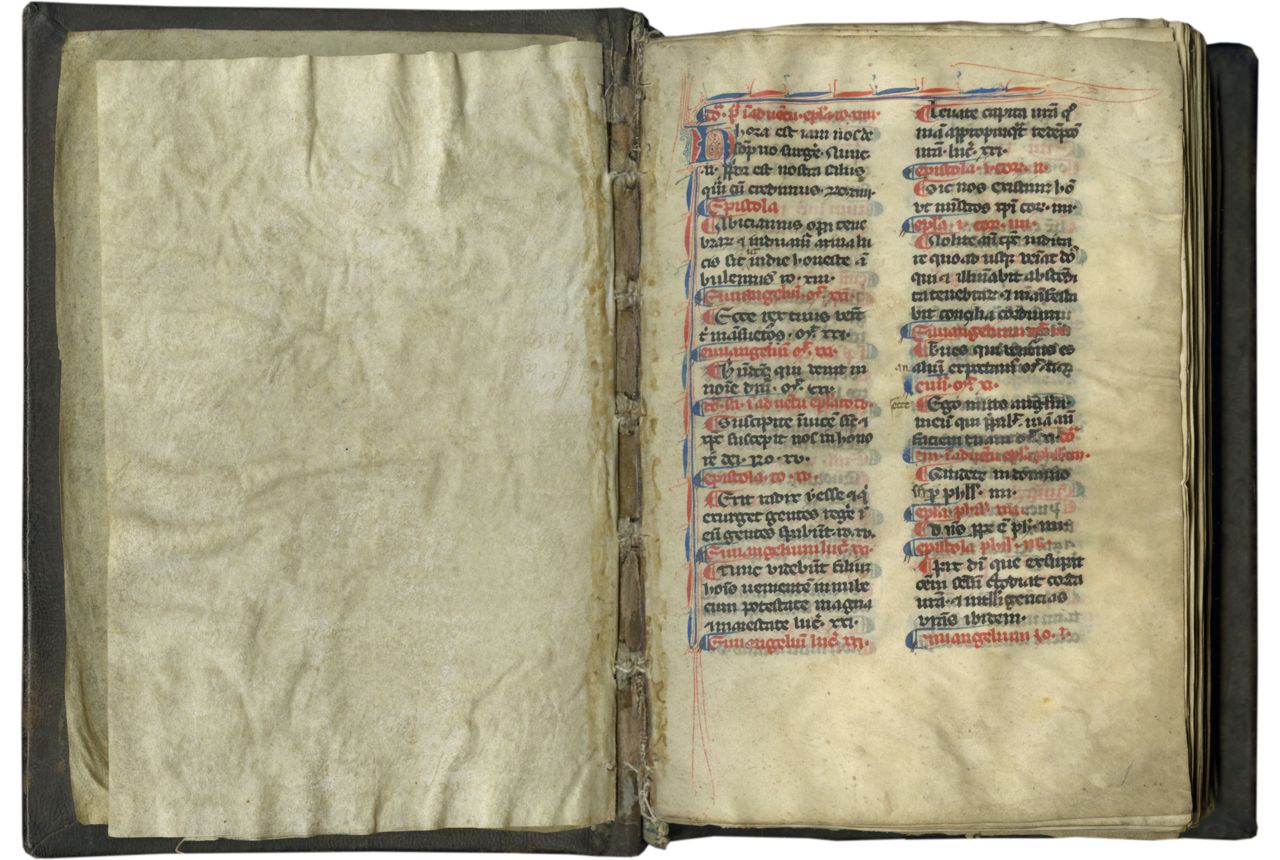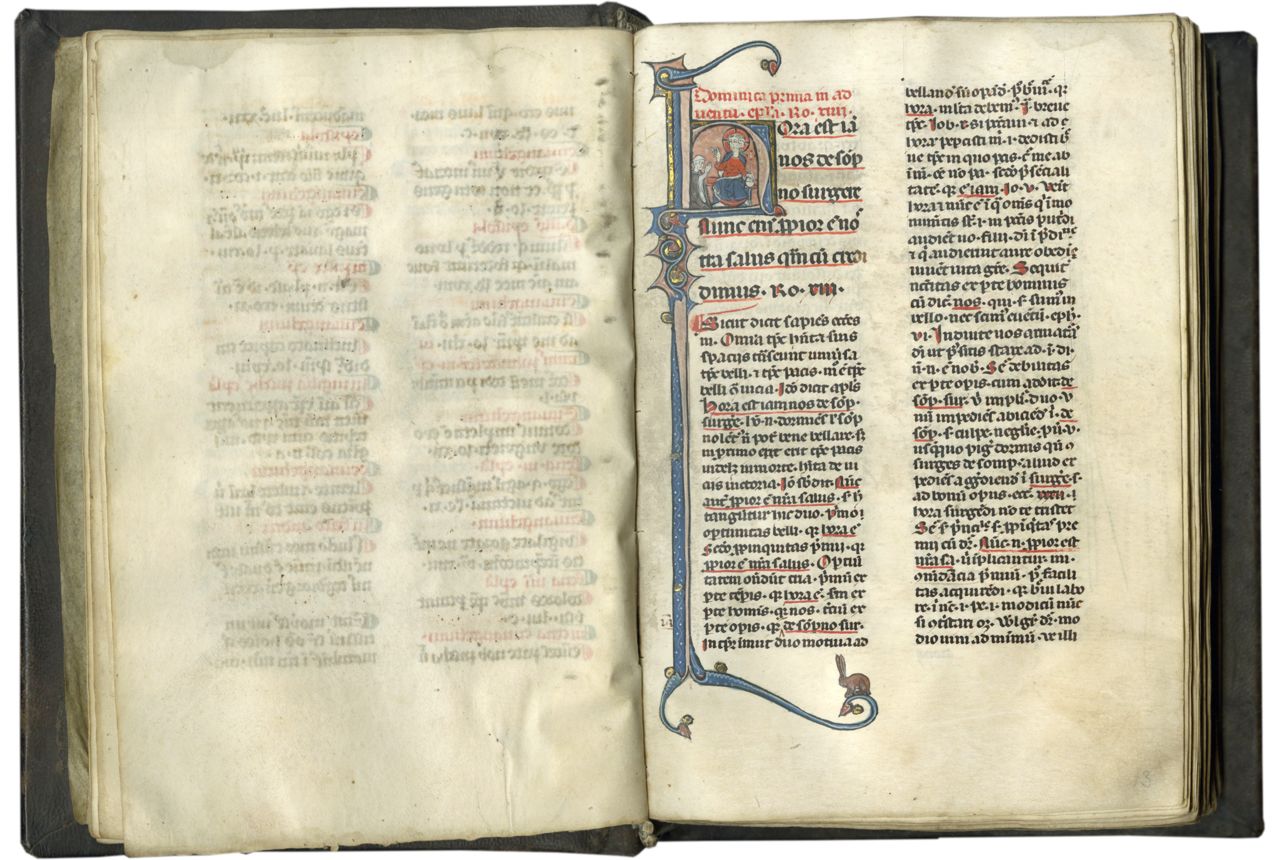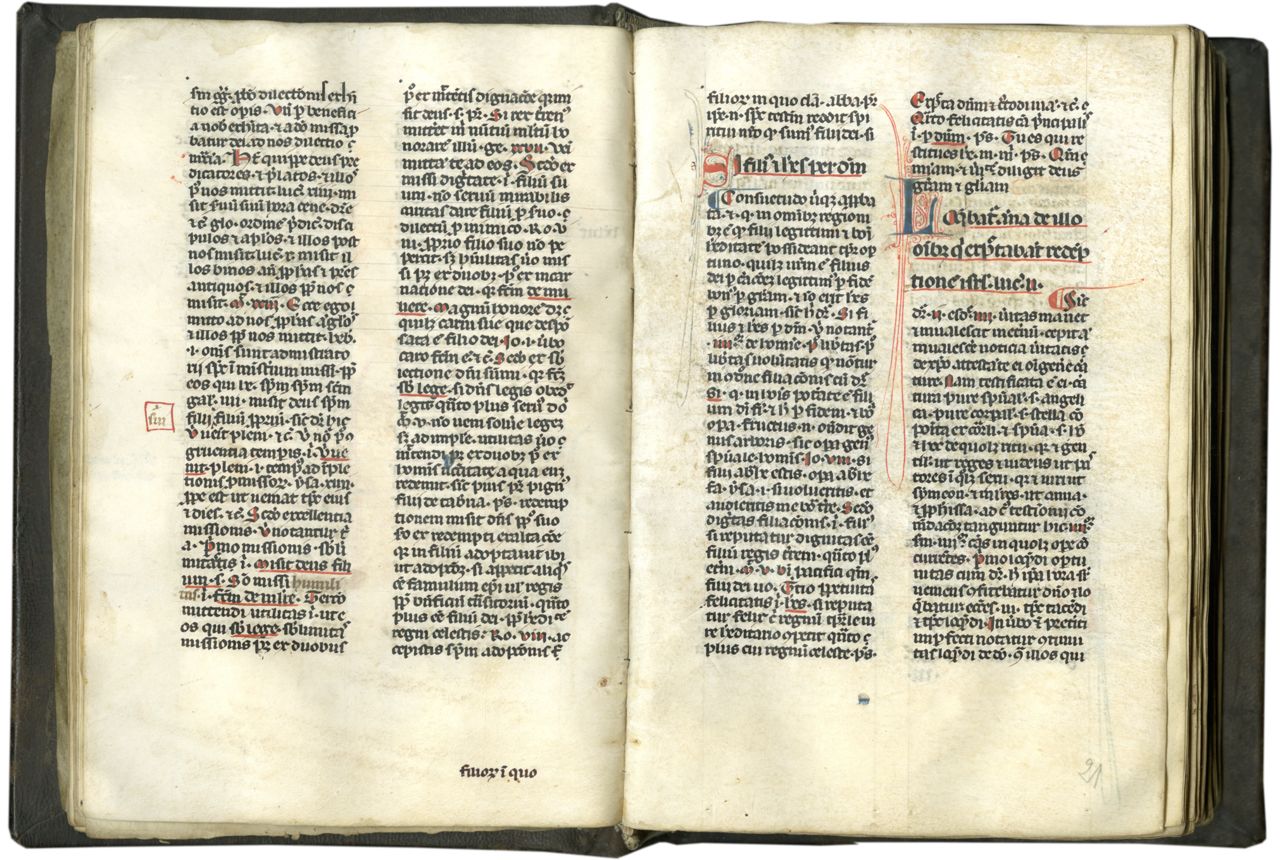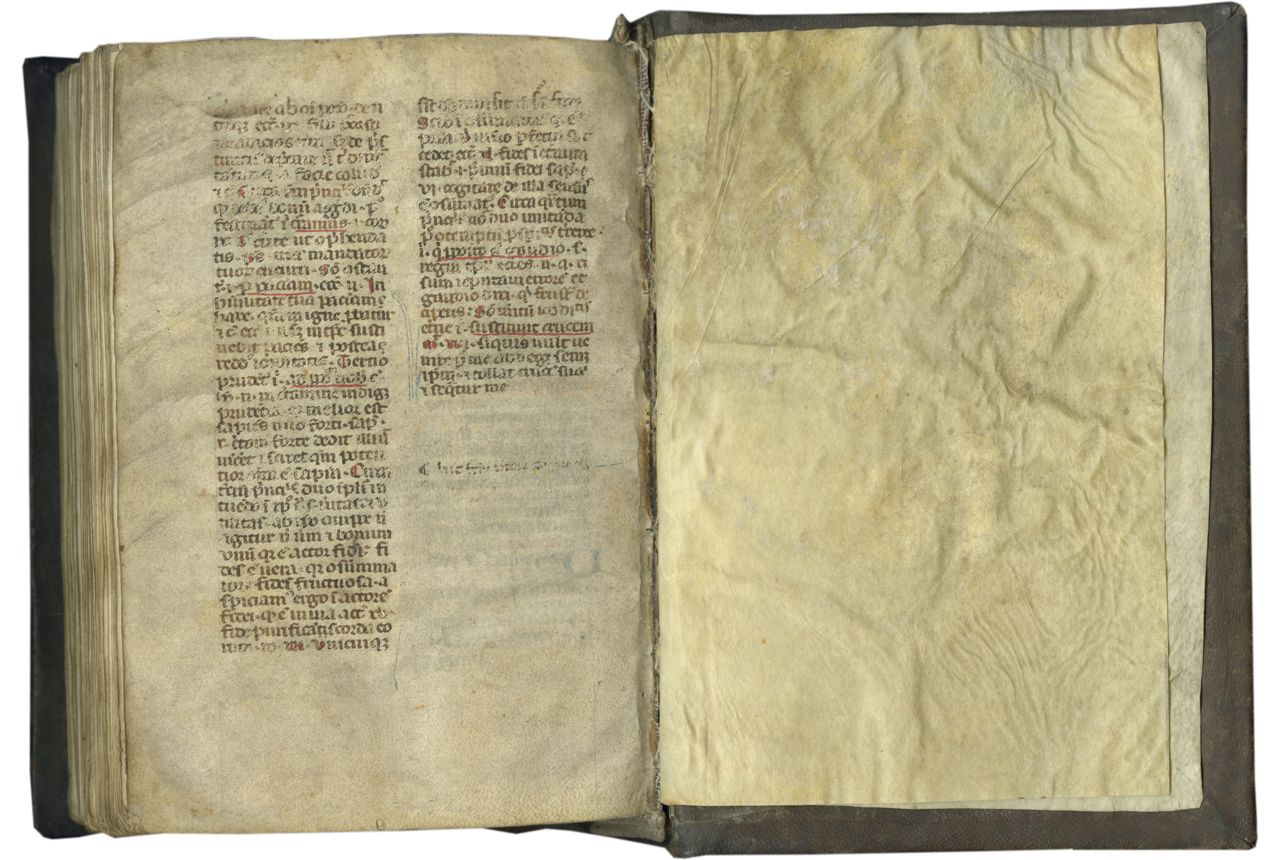i + 136 + i folios on parchment, modern foliation in pencil, lower outer rectos, 1-136, complete (collation i10 ii2 iii8 iv-ix12 x12 [+1; tipped in singleton f. 93] xi8 [-8, + 8: tipped-in singleton f. 113 appears to replace a leaf that was removed] xii12 xiii12 [-12; canceled with no loss of text]), horizontal catchwords, lower inner versos, in qq. i, iii-x, xii, leaf signatures, partially cropped, in q. i, ruled in lead with full-length vertical bounding lines and one full-length horizontal bounding line across the top of the page (additional full-length horizontal bounding line and lines in lower margin in the table of contents), prickings visible in upper and lower margins (justification 143-147 x 94-98 mm.), written under top line in three Gothic bookhands: (1) ff. 1-12, in black ink in two columns of thirty lines, (2) ff. 13-92v, 94-112v, 114-136v, in two columns of thirty-five lines, (3) ff. 93rv, 113v, in light brown ink in two columns of thirty-four to thirty-six lines, capitals touched in red in stints of scribes 2 and 3, guide notes for rubricator, guide marks for paraphs, guide letters for initials, rubrics in red, underlining of some sermon themes and biblical passages in red, one-line paraphs in red or blue, two-line initials in red or blue with contrasting pen decorations in blue or red at the beginning of each sermon in scribe 2’s stint (scribe 3 left space for two- to four-line initials, never added), one two-line parted initial in red and blue, with pen decoration in blue and red extending in a half border (f. 1), ONE ILLUMINATED, HISTORIATED INITIAL in six lines, painted in light pink on light pink and dark blue grounds, edged in burnished gold, with border extensions along one side of the text (f. 13), corrections in several contemporary hands, including the hand that wrote the guide notes for the rubricator, several substantial, contemporary additions in lower margin (see especially f. 75v) outlined in red and written in a hand like that of scribe 3, marginal annotation throughout in a hybrida script (see, for example, ff. 16, 46, 56, 68, 83), slight water staining along the upper edges of some leaves, with no loss of text, f. 136v soiled and slightly faded, but still legible, parchment cut away from the lower margins of ff. 11 and 62 and from the lower and outer margin of f. 113, all with no loss of text, in very fine condition over all. Bound in nineteenth- or twentieth-century dark brown leather over beveled wood boards, spine with five raised bands, four metals bosses on both upper and lower boards. Dimensions 203 x 139 mm.
A very early collection of the still unedited sermons of the influential Dominican preacher and royal advisor Nicholas of Gorran, this manuscript is an extremely important witness, having been copied during the author’s lifetime, possibly even with his supervision. Changes to this volume early on may reveal Nicholas’s intentions as he shaped these sermons at the Dominican convent of Saint-Jacques in Paris. Handsomely decorated, with a charming illuminated initial depicting the author receiving Christ’s blessing, this was quite possibly made for a recipient of some importance.
Provenance
1. The style of script and decoration in this manuscript is consistent with it having been produced in Northern France, possibly Paris, in the final quarter of the thirteenth century, c. 1275-1300. The filigree initials are typical of Parisian production after 1270 (see Stirnemann, 1990, nos. 43, 44, and 46). The style of the illuminated initial finds its origins in the Parisian workshops active in the final third of the thirteenth century. It bears similarities in style to the output of the Bari atelier, active in Paris c. 1250-1270, and more particularly to offshoots of that atelier. Finer examples of such offshoots can be found in Paris, Bibliothèque nationale de France, MSS lat. 10489, fr. 899, and lat. 830 (see Branner, 1997, pp. 102-7, figs. 292 and 296, and pl. XX).
It is tempting to speculate that this collection of sermons, produced during the lifetime of the author, may have been compiled or emended (or both) under his supervision at the Dominican convent of Saint-Jacques in Paris. The manuscript certainly bears signs of early changes, perhaps because the texts of some of the sermons were still in a state of flux at that early date (see Text section, below). Saint-Jacques was the primary Dominican convent in Paris and site of the Dominican studium where Nicholas of Gorran received his own training. Founded in 1218, the convent quickly became a place for serious study for members of the newly formed Dominican Order and was incorporated into the university of Paris shortly after 1220.
The care that went into producing this manuscript, as well as the quality of its decoration, both strongly suggest that this was made for an important recipient.
2. A business card for Fulgence, Paris dealer in objets d’art, bears the name and address of one Monsieur Chrétien on the reverse, given for the sale of a manuscript, presumably this one.
3. Three pages of notes on the manuscript and its textual contents (in French), inserted loosely into the front of the volume, are dated October 1938 and signed, “T. Chenu.” One T. Chenu is listed as a newly nominated member of the Société préhistorique française in the society’s 1934 Bulletin.
4. A newspaper clipping inserted loosely into the front of the volume records the details of the 16 December 1953 Hôtel Drouot sale of the library of André Hachette (1873-1945). Further investigation may reveal whether this manuscript was part of the same sale or whether the sale was simply of interest to the manuscript’s owner.
Text
ff. 1-12, [table of contents] Dominica prima in aduentu epistola romanis xiiij, incipit, “Hhora [sic] est iam nos de sompno surgere ... Erat moyses uir mitissimus super omnes homines qui morabantur in terra numeri. xii.a. [Numbers 12:3]”; [f. 12v, blank];
ff. 13-92v, Dominica prima in aduentu epistola Romanis xiiij, incipit, “HOra est iam nos de sompno surgere Nunc enim propior est nostra salus quam cum credidimus. Ro. xiij. [Romans 13:11] Sicut dicit sapiens ecclesiastes iii. Omnia tempus habent ... Tercio humilitatis utilitas ibi in mundum Jo. xiii [John 12:47] non ueni ut iu[dicem]”;
Sermons for the Temporale from the first Sunday in Advent to the twenty-fourth Sunday after Trinity Sunday (Schneyer, 1972, pp. 255-73: nos. 1-97, 106-137, 144-150, 157-162, 166-210, 212-274).
ff. 93-112, Feria quarta quadragesime, incipit, “[M]emor esto vnde excideris et age penitentiam et prima opera fac ap. ij. [Apocalypse 2:5] Verbum propositum ad peccatorem dirigitur ... Ps. [Psalms 45:9] Venite et uidete opera domini que posuit prodigia etc.”;
Lenten sermons from the beginning of Lent until Holy Saturday (Schneyer, 1972, pp. 273-79: nos. 275-276, 283-248, 355-360, 374). Between Schneyer nos. 360 and 374 are five sermons not included in Schneyer, but included in the 1620 edition of Nicholas of Gorran’s sermons (see ff. 111-112).
f. 112v, In festo andree, incipit, “IN baculo meo transiui iordane istum et nunc cum duabus turmis regredior. Gen. xxxij. [Genesis 32:10] Sicut dicitur Sap. ii. [Wisdom 2:5] Vmbrae transitus est tempus nostrum ... mansuetudo in sustinendis//;” [f. 113, blank];
Sermons for the feast of Saint Andrew, ending imperfectly (Schneyer, 1972, p. 281: nos. 375-376).
ff. 113v-136v, Ad reliosos [sic] gen, incipit, “[N]E queso sit iurgium inter me et te et pastores meos et pastores tuos fratres enim sumus [Genesis 13:8] Voluit diuina sapiencia ut omnes homines propagarentur ex uno ... si quis uult uenire post me abneget semetipsum et tollat crucem suam et sequatur me. Hic [...?].”
Sermons for various occasions, including sermons for members of religious orders (Schneyer, 1972, pp. 318-19: nos. 951-958), for visitations (Schneyer, 1972, pp. 317-18: nos. 926, 941-943), for synods (Schneyer, 1972, p. 316: nos. 913-919), for the dedications of churches (Schneyer, 1972, pp. 314-15: nos. 894, 900-902), for the dedications or consecrations of altars (Schneyer, 1972, p. 315: nos. 903-905), for the elections of prelates (Schneyer, 1972, p. 318: nos. 944-947), for the first masses of new priests (Schneyer, 1972, p. 318: nos. 948-950), in orders (Schneyer, 1972, pp. 317-18: nos. 927-940), for entrance into religious orders (Schneyer, 1972, p. 319: nos. 959-963), to entreat serenity (Schneyer, 1972, pp. 319-20: nos. 964-973), and at the cross (Schneyer, 1972, p. 320: no. 974). Between Schneyer nos. 894 and 900, there is one theme for a sermon on the same subject (the dedication of a church) that is not included in Schneyer (f. 120). Following Schneyer no. 974, there are three sermons on the same subject (the cross) that are not included in Schneyer (ff. 135v-136v).
A very fine and notably early collection of sermons by Nicholas of Gorran, this volume includes his sermons for the entire liturgical year, as well as sermons for particular special occasions. There is no modern critical edition of these sermons. They circulated widely during the Middle Ages and beyond; Schneyer lists 102 manuscripts containing Nicholas’s Sermones de tempore et de quadragesima (1972, pp. 279-80), as well as nineteen additional manuscripts containing Nicholas’s Sermones de sanctis and forty-one manuscripts containing single sermons from these collections (1972, pp. 321-22), and Kaeppeli supplements Schneyer’s list with thirteen additional manuscripts (1980, no. 3091, pp. 167-68). Nicholas’s Sermones de tempore were first printed in Cologne in 1478 and his collected sermons were first printed in Paris in 1523 under the title Fundamentum aureum (see Online Resources, below). Though preserved in many manuscripts, collections of Nicholas’s sermons are rare on the market; the Schoenberg Database lists only one other copy for sale in the last century and we know of only one additional copy from the market (now at the Honnold Mudd Library in Claremont, California).
Illustration
One historiated initial:
f. 13, Christ sits enthroned, blessing a Dominican friar, who kneels before him.
Robed in red with a mantle of blue, the figure Christ stands out against a pale pink background. The features of both Christ and the Dominican friar have been executed in fine penwork, with delicately drawn, wide-open eyes, downturned mouths, and long noses with rounded tips, all set within long faces with rounded chins. Drawn with large heads set above slim shoulders, both figures are outlined with broader lines that bring out some of the folds of the drapery as well. Burnished gold frames the initial and punctuates the border, while white penwork adorns the pale pink and dark blue initial, its grounds, and the border that extends from it, terminating in gracefully curving extensions, each ending with a single leaf. A brown rabbit perches upon one of these curved extensions.
Placed at the opening of the first sermon in this single-author collection, this initial almost certainly depicts the author, clad in the robes of his Order, kneeling before Christ and receiving his blessing. A prominent Dominican preacher and scriptural commentator, Nicholas of Gorran (1232-1295) exerted an important impact on how scripture was read, interpreted, and preached in the thirteenth century and beyond. He first entered the Dominican convent in Gorron before he was sent on for further education at the famous studium of Saint-Jacques, the Dominican convent in Paris. He became prior of Saint-Jacques in 1280, and would remain there until his death. During his time in Paris, he also served as confessor and advisor to Philip IV of France (reigned 1285-1314).
Nicholas of Gorran was esteemed as an interpreter of scripture, and his commentaries on various scriptural books circulated widely, powerfully influencing later preachers. His sermons also number among the valuable tools he produced for preachers, as does his famous collection of biblical distinctiones, that is, words from the Bible, classified according to their different spiritual or theological senses, for use in preaching. This copy of Nicholas’s sermons was almost certainly used early on as a preaching aid. It bears markings in several different hands, many of which appear quite systematically throughout the book, designating passages or sermons of particular interest. At least one later user also left corrections and annotations in the margins.
Before this book saw use by other readers, however, it underwent some interesting emendations that suggest the sermon collection was still in flux and may even indicate authorial supervision by Nicholas of Gorran. For example, the opening leaves of both the Lenten sermons (ff. 93-112) and the sermons for various occasions (ff. 113v-136v) were replaced early on; ff. 93 and 113 are tipped in leaves, both copied by a different scribe than the rest of the sermons, notably in a hand markedly similar to that in which most of the corrections were made throughout the manuscript. These leaves might have been added simply to allow edits to the opening sermons of both collections. Alternatively (or additionally), they may have been supplied to facilitate a reordering of the book’s contents, which also took place early on. The table of contents reveals that the sermons for various occasions (ff. 113v-136v) were initially placed between the sermons for the Temporale (ff. 13-92v) and the Lenten sermons (ff. 93-112), but were then moved to follow rather than precede the Lenten sermons (ff. 93-112); ff. 93 and 113 may have been tipped in to accommodate this rearrangement. And even before this repositioning, someone had made an executive decision not to include Nicholas’s sermons for the feasts of saints in full, cutting off the second of the two sermons for the feast of Saint Andrew in the middle (see f. 112v). That this was a deliberate decision and not a later loss is born out by the table of contents, which stops at precisely the same point, although room remains for further sermons to be listed, had there been any to list.
These sermons have received relatively little attention in scholarship, owing in part, no doubt, to their never having been edited. As a very early witness to many of Nicholas’s sermons, and one that may preserve the traces of his own interventions, this manuscript merits careful consideration in future studies of Nicholas’s work and, in particular, in any future edition of his sermons. This handsome volume has much to tell us about Nicholas’s work and even, possibly, his intentions in shaping it.
Literature
Branner, Robert. Manuscript Painting in Paris During the Reign of Saint Louis: A Study of Styles, Berkeley, University of California Press, 1977.
D’Avray, David L. The Preaching of the Friars: Sermons Diffused from Paris before 1300, Oxford, Clarendon Press, 1985.
Kaeppeli, Thomas. Scriptores Ordinis Praedicatorum Medii Aevi, vol. 3, Rome, 1980.
Kienzle, B. M. The Sermon, Typologie des Sources du Moyen Âge Occidental 81-83, Turnhout, Brepols, 2000.
Mulchahey, Marian Michèle. “First the Bow is Bent in Study”: Dominican Education before 1350, Toronto, Pontifical Institute of Mediaeval Studies, 1998.
Roberts, Phyllis. “The Ars Praedicandi and the Medieval Sermon,” in Preacher, Sermon and Audience in the Middle Ages, ed. Carolyn Muessig, Leiden, Brill, 2002, pp. 279-292.
Schneyer, Johannes Baptist. Repertorium der lateinischen Sermones des Mittelalters für die Zeit von 1150-1350, Beiträge zur Geschichte der Philosophie und Theologie des Mittelalters 43, vol. 4, Münster, Aschendorffsche Verlagsbuchhandlung, 1972.
Stirnemann, Patricia. “Fils de la vierge: l’initiale à filigranes parisienne: 1140-1314,” Revue de l’Art 90 (1990), pp. 58-73.
Online Resources
Kienzle, Beverly Mayne and John Zaleski. A History of Medieval Preaching as Seen in the Manuscripts of Houghton Library, 2012
http://hcl.harvard.edu/libraries/houghton/collections/early_manuscripts/preaching/index.cfm
Nicholas of Gorran. Fundamentum aureum olim totiusque anni sermonum ..., Paris, 1523
https://books.google.com/books?id=AKZ32Ggtfp8C&printsec=frontcover#v=onepage&q&f=false
Nicholas of Gorran. Omnium anni sermonvm fvndamentvm avrevm, Antwerp, 1620
https://books.google.com/books?id=4NgYua3qqXUC&printsec=frontcover#v=onepage&q&f=false
O’Connor, John Bonaventure. “Nicholas of Gorran,” The Catholic Encyclopedia, vol. 11, New York, 1911
http://www.newadvent.org/cathen/11062b.htm
Sermones.net: Édition électronique d’un corpus de sermons latins médiévaux
http://sermones.net/
TM 868


